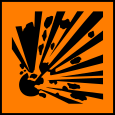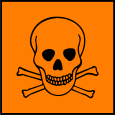Danger symbol
The hazard symbols were a set of pictograms on an orange background, which, together with a specific hazard designation, gave an initial, easily recognizable indication of the dangers posed by a hazardous substance .
The validity of the hazard symbols extended to the European Economic Area as well as Switzerland; since June 1, 2015 (or June 1, 2017) they have been replaced by the internationally valid labeling of the globally harmonized system for the classification and labeling of chemicals (GHS). Since then, hazard pictograms have been used .
The R and S phrases with which all packaging of such substances had to be labeled gave further information in terms of EU law on hazardous substances and how to handle them.
History and legal basis
precursor
The first definition of pictorial symbols for international traffic with dangerous substances, which should also be understandable for "non-literate" users, was made in February 1955 during the 4th meeting of the Committee on the Chemical Industry at the International Labor Office in Geneva. They were published in DIN-Mitteilungen in the same year.
Substance directive
The legal basis for the hazard symbols was the 67/548 / EEC directive (substance directive ), which came into force on January 1st, 1970. The hazard symbols are included in Appendix II. The European Chemicals Bureau (ECB) was responsible for standardization and control .
The Workplace Hazardous Materials Information System (WHMIS) is valid for Canada .
Introduction of the GHS
The provisions of Directive 67/548 / EEC were integrated into Regulation (EC) No. 1272/2008 of the European Parliament and of the Council published on December 31, 2008 , together with the globally harmonized system for the classification and labeling of chemicals that replaces them ( GHS). With this system, which has been developed by a UN commission since 1992, the warning symbols for hazardous substances are redefined as GHS hazard pictograms and standardized worldwide. The validity of the previous hazard symbols with their hazard warnings (as well as the R and S phrases ) was therefore limited to the transition periods specified in the GHS. Since December 1st, 2010, substances have to be labeled according to GHS, the transitional regulation expired on December 1st, 2012. The new regulation has been in effect for mixtures since June 1, 2015. There was also a two-year transition period here: the old labeling could still be used until June 1, 2017 for stocks.
While the old hazard symbols are squares in orange, the new hazard pictograms are diamonds in white with a red border. The pictograms shown - symbolic images of the hazard - are largely similar (the hazard symbols in diamonds on different solid colors are used for the dangerous goods classes according to ADR / RID of the transport sector).
Hazard symbols
The hazard symbols form 3 groups, whereby a hierarchy must be observed for the labeling:
| Fire | health | environmental Protection | |||||
|---|---|---|---|---|---|---|---|
| E. | Explosive | T + | Very poisonus | N | Dangerous for the environment | ||
| F + | Extremely flammable | T | Toxic | ||||
| F. | Flammable | C. | Corrosive | ||||
| O | Oxidising | Xn | Harmful to health | Xi | Lovely | ||
If 2 symbols from a vertical line apply, only the one furthest up has been used. In the “Health” group, this also applied from left to right, but with the exception that C remained next to T if it was a CMR substance (carcinogenic, mutagenic or toxic to reproduction).
This resulted in a maximum of 4 symbols for a hazardous substance (example: chromium (III) chromate : O, T, C, N).
Overview of hazard symbols
The symbols are listed below in the order above:
| Hazard symbol hazard designation |
Code letter 1 hazard designation |
Significance (danger and instructions for use) | Main Products |
|---|---|---|---|

|
E (EN) Explosive (FR) Explosif (IT) Esplosivo (ES) Explosivo (PT) Explosivo |
Danger: Substances that can explode under certain conditions. The dangers described under F +, F and O can also emanate from substances labeled in this way; in these cases these symbols do not have to be indicated additionally. Handling: Avoid shock, impact, friction, sparking and exposure to heat. |
Explosive substances |

|
F + (EN) Extremely flammable (FR) Extrêmement inflammable (IT) Estremamente infiammabile (ES) Extremadamente inflamable (PT) Extremamente inflamável |
Danger: Self-igniting substances, highly flammable gaseous substances, moisture-sensitive substances or flammable liquids. Handling: Avoid contact with ignition sources / sources of danger (air, water). |
Highly flammable substances |

|
F (EN) Highly flammable (FR) Facilement inflammable (IT) Facilmente infiammabile (ES) Fácilimente inflamable (PT) Facilmente Inflamável |
Danger: Self-igniting substances, highly flammable gaseous substances, moisture-sensitive substances or flammable liquids. Handling: Avoid contact with ignition sources / sources of danger (air, water). |
Highly flammable substances |

|
O (EN) Oxidizing (FR) Comburant (IT) Comburente (ES) Comburente (PT) Comburente |
Danger: Substances that can ignite flammable substances or encourage fires that have broken out and thus make fire fighting more difficult. Handling: Avoid all contact with flammable materials. |
Oxidising substances |

|
T + (EN) Very toxic (FR) Très toxique (IT) Molto tossico (ES) Muy tóxico (PT) Muito Tóxico |
Danger: After inhalation, ingestion or absorption through the skin, there is usually considerable damage to health or even death. Less than 25 mg per kilogram of body weight can lead to death. The dangers described under Xn, Xi and C can also emanate from substances labeled in this way; in these cases these symbols do not have to be indicated additionally. Handling: Avoid any contact with the human body and consult a doctor immediately if you feel unwell. |
Toxic substances |

|
T (EN) Toxic (FR) Toxique (IT) Tossico (ES) Tóxico (PT) Tóxico |
Danger: After inhalation, swallowing or absorption through the skin, damage to health of a considerable extent usually occurs; 25–200 mg per kilogram of body weight can be fatal. The dangers described under Xn, Xi and C can also emanate from substances labeled in this way; in these cases these symbols do not have to be indicated additionally. However, according to RL 67/548 EEC, the labeling with C next to T remains if the latter is based on a carcinogenic, mutagenic or teratogenic effect. Handling: Avoid any contact with the human body and consult a doctor immediately if you feel unwell. |
Toxic substances |

|
Xn (EN) Harmful (FR) Nocif (IT) Nocivo (ES) Nocivo (PT) Nocivo |
Danger: If absorbed into the body, these substances can be harmful to health. Handling: Avoid contact with the human body, including inhalation of the vapors, and consult a doctor if you feel unwell. The dangers described under Xi can also emanate from substances labeled in this way; in these cases this symbol does not have to be indicated additionally. |
Substances harmful to health |

|
C (EN) Corrosive (FR) Corrosif (IT) Corrosivo (ES) Corrosivo (PT) Corrosivo |
Danger: Living tissue, but also many materials, are destroyed when they come into contact with this chemical. The dangers described under Xn and Xi can also emanate from substances labeled in this way; in these cases these symbols do not have to be indicated additionally. Handling: Do not inhale vapors and avoid contact with skin, eyes and clothing. |
Corrosive substances |

|
Xi (EN) Irritant (FR) Irritant (IT) Irritante (ES) Irritante (PT) Irritant |
Danger: substances with irritating effects on skin, eyes and respiratory organs; can cause inflammation. Handling: Do not inhale vapors and avoid contact with skin and eyes. |
Irritating substances |

|
N (EN) Dangerous for the environment (FR) Dangereux pour l'environnement (IT) Pericoloso per l'ambiente (ES) Peligroso para el medio ambiente (PT) Perigoso para o meio ambiente |
Danger: If released into the environment, damage to the ecosystem can be brought about immediately or later. Handling: Depending on the hazard potential, do not allow to enter the sewage system, soil or the environment. Observe special disposal regulations! |
Environmentally hazardous substances |
Identification letters
Additional uses of the symbols T, Xn and Xi
The symbols Xn, Xi and T were also used for CMR substances (carcinogenic, mutagenic, toxic to reproduction) and allergens , although z. B. for carcinogenic substances there is no acute toxicity. However, if such substances are also acutely toxic, note E applies ; Even acutely very toxic substances were marked with T +.
| Dangerous feature and |
Significance (danger and instructions for use) |
|---|---|
|
Carcinogenic |
Danger: Substances are carcinogenic if they can cause cancer or increase the incidence of cancer when inhaled, swallowed or absorbed through the skin. Handling: Avoid contact with the body - also ingestion or inhalation. Contact a doctor immediately in the event of contact. |
|
Mutagenic |
Danger: Substances are mutagenic if they can cause heritable genetic damage or increase their frequency when inhaled, swallowed or absorbed through the skin. Handling: Avoid contact with the body - also ingestion or inhalation. Contact a doctor immediately in the event of contact. |
|
Toxic to reproduction |
R 60 "May impair fertility." R 61 "May cause harm to the unborn child." (Summarized with "Suspected reproductive toxicity") Danger: Substances are toxic to reproduction (toxic to reproduction) if they cause non-heritable damage to the offspring when they are inhaled, swallowed or absorbed through the skin, or if they increase their frequency (teratogenic) or impair the male reproductive functions or ability. |
| Suspicion of … |
R 40 "Suspicion of a carcinogenic effect", R 62 "May impair fertility", Danger: If absorbed into the body, these substances can cause long-term health damage. Handling: Avoid contact with the human body, including inhalation of the vapors. |
|
Sensitizing |
Danger: R 42 "May Handling: R 42: Avoid all contact by inhalation of gas / vapor / smoke / aerosol. R 43 “May cause sensitization by skin contact.” (Xi) Handling: R 43: Avoid all contact by skin contact. |
See also
- Warning signal - general information
- Warning signs according to DIN 4844-2
- Dangerous goods according to ADR
- Hazard diamond according to NFPA 704
- Globally harmonized system for the classification and labeling of chemicals
- R and S phrases
- CMR fabric
- Safety data sheet
- Safety mark
- Number to identify the hazard (Kemler number)
Web links
- Directive 67/548 / EEC as a whole, version 2006 (table of contents for PDF documents)
Individual evidence
- ↑ Römpp Lexikon Chemie, 6th edition, 1966.
- ↑ DIN-Mitteilungen, Vol. 34, No. 4, 1955. (DIN 4818)
- ↑ EU Official Journal L353 with Regulation (EC) No. 1272/2008 of the European Parliament and of the Council (GHS Regulation with all new regulations and labels) (PDF)
- ^ Entry on chromium (III) chromate in the GESTIS substance database of the IFA , accessed on August 25, 2011 (JavaScript required)




